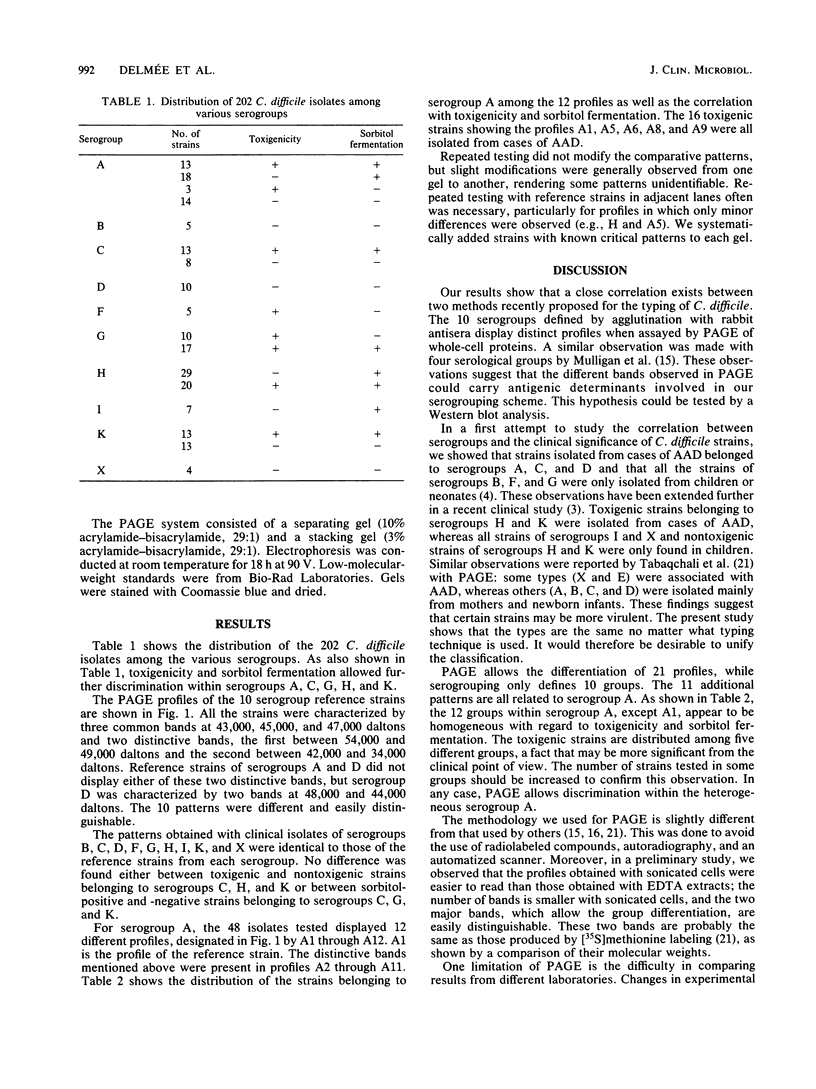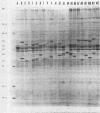Abstract
A typing scheme for Clostridium difficile based on slide agglutination with rabbit antisera was previously described. It allows the differentiation of 10 serogroups designated A, B, C, D, F, G, H, I, K, and X. We studied the correlation between serogrouping and polyacrylamide gel electrophoresis (PAGE) of whole-cell proteins. A total of 202 isolates from different sources were analyzed by PAGE after ultrasonic disintegration of cells from an 18-h liquid culture and treatment with sodium dodecyl sulfate and 2-mercaptoethanol. A total of 21 different patterns were observed. The reference strains from the 10 serogroups showed different profiles. For each serogroup except A, the patterns obtained with the clinical isolates were identical to the patterns obtained with the reference strains. For the 48 strains belonging to serogroup A, 12 different profiles were observed. Five of these involved strains isolated from patients with antibiotic-associated diarrhea. Typing by sodium dodecyl sulfate-PAGE thus correlates with serogrouping. In addition, it allows discrimination within the heterogeneous serogroup A.
Full text
PDF



Images in this article
Selected References
These references are in PubMed. This may not be the complete list of references from this article.
- Al-Jumaili I. J., Shibley M., Lishman A. H., Record C. O. Incidence and origin of Clostridium difficile in neonates. J Clin Microbiol. 1984 Jan;19(1):77–78. doi: 10.1128/jcm.19.1.77-78.1984. [DOI] [PMC free article] [PubMed] [Google Scholar]
- Bartlett J. G., Chang T. W., Gurwith M., Gorbach S. L., Onderdonk A. B. Antibiotic-associated pseudomembranous colitis due to toxin-producing clostridia. N Engl J Med. 1978 Mar 9;298(10):531–534. doi: 10.1056/NEJM197803092981003. [DOI] [PubMed] [Google Scholar]
- Delmee M., Bulliard G., Simon G. Application of a technique for serogrouping Clostridium difficile in an outbreak of antibiotic-associated diarrhoea. J Infect. 1986 Jul;13(1):5–9. doi: 10.1016/s0163-4453(86)92095-5. [DOI] [PubMed] [Google Scholar]
- Delmee M., Homel M., Wauters G. Serogrouping of Clostridium difficile strains by slide agglutination. J Clin Microbiol. 1985 Mar;21(3):323–327. doi: 10.1128/jcm.21.3.323-327.1985. [DOI] [PMC free article] [PubMed] [Google Scholar]
- George W. L., Sutter V. L., Goldstein E. J., Ludwig S. L., Finegold S. M. Aetiology of antimicrobial-agent-associated colitis. Lancet. 1978 Apr 15;1(8068):802–803. doi: 10.1016/s0140-6736(78)93001-5. [DOI] [PubMed] [Google Scholar]
- Heard S. R., O'Farrell S., Holland D., Crook S., Barnett M. J., Tabaqchali S. The epidemiology of Clostridium difficile with use of a typing scheme: nosocomial acquisition and cross-infection among immunocompromised patients. J Infect Dis. 1986 Jan;153(1):159–162. doi: 10.1093/infdis/153.1.159. [DOI] [PubMed] [Google Scholar]
- Kliegman R. M., Hack M., Jones P., Fanaroff A. A. Epidemiologic study of necrotizing enterocolitis among low-birth-weight infants. Absence of identifiable risk factors. J Pediatr. 1982 Mar;100(3):440–444. doi: 10.1016/s0022-3476(82)80456-3. [DOI] [PubMed] [Google Scholar]
- Larson H. E., Barclay F. E., Honour P., Hill I. D. Epidemiology of Clostridium difficile in infants. J Infect Dis. 1982 Dec;146(6):727–733. doi: 10.1093/infdis/146.6.727. [DOI] [PubMed] [Google Scholar]
- Larson H. E., Price A. B., Honour P., Borriello S. P. Clostridium difficile and the aetiology of pseudomembranous colitis. Lancet. 1978 May 20;1(8073):1063–1066. doi: 10.1016/s0140-6736(78)90912-1. [DOI] [PubMed] [Google Scholar]
- Mandal B. K., Watson B., Ellis M. Pseudomembranous colitis in a 5-week-old infant. Br Med J (Clin Res Ed) 1982 Jan 30;284(6312):345–346. doi: 10.1136/bmj.284.6312.345-c. [DOI] [PMC free article] [PubMed] [Google Scholar]
- Mathew O. P., Bhatia J. S., Richardson C. J. An outbreak of Clostridium difficile necrotizing enterocolitis. Pediatrics. 1984 Feb;73(2):265–266. [PubMed] [Google Scholar]
- Miller S. D., Koornhof H. J. Clostridium difficile colitis associated with the use of antineoplastic agents. Eur J Clin Microbiol. 1984 Feb;3(1):10–13. doi: 10.1007/BF02032807. [DOI] [PubMed] [Google Scholar]
- Milligan D. W., Kelly J. K. Pseudomembranous colitis in a leukaemia unit: a report of five fatal cases. J Clin Pathol. 1979 Dec;32(12):1237–1243. doi: 10.1136/jcp.32.12.1237. [DOI] [PMC free article] [PubMed] [Google Scholar]
- Mulligan M. E., Halebian S., Kwok R. Y., Cheng W. C., Finegold S. M., Anselmo C. R., Gerding D. N., Peterson L. R. Bacterial agglutination and polyacrylamide gel electrophoresis for typing Clostridium difficile. J Infect Dis. 1986 Feb;153(2):267–271. doi: 10.1093/infdis/153.2.267. [DOI] [PubMed] [Google Scholar]
- Poxton I. R., Aronsson B., Möllby R., Nord C. E., Collee J. G. Immunochemical fingerprinting of Clostridium difficile strains isolated from an outbreak of antibiotic-associated colitis and diarrhoea. J Med Microbiol. 1984 Jun;17(3):317–324. doi: 10.1099/00222615-17-3-317. [DOI] [PubMed] [Google Scholar]
- Richardson S. A., Alcock P. A., Gray J. Clostridium difficile and its toxin in healthy neonates. Br Med J (Clin Res Ed) 1983 Sep 24;287(6396):878–878. doi: 10.1136/bmj.287.6396.878. [DOI] [PMC free article] [PubMed] [Google Scholar]
- Sell T. L., Schaberg D. R., Fekety F. R. Bacteriophage and bacteriocin typing scheme for Clostridium difficile. J Clin Microbiol. 1983 Jun;17(6):1148–1152. doi: 10.1128/jcm.17.6.1148-1152.1983. [DOI] [PMC free article] [PubMed] [Google Scholar]
- Sherertz R. J., Sarubbi F. A. The prevalence of Clostridium difficile and toxin in a nursery population: a comparison between patients with necrotizing enterocolitis and an asymptomatic group. J Pediatr. 1982 Mar;100(3):435–439. doi: 10.1016/s0022-3476(82)80455-1. [DOI] [PubMed] [Google Scholar]
- Tabaqchali S., Holland D., O'Farrell S., Silman R. Typing scheme for Clostridium difficile: its application in clinical and epidemiological studies. Lancet. 1984 Apr 28;1(8383):935–938. doi: 10.1016/s0140-6736(84)92392-4. [DOI] [PubMed] [Google Scholar]
- Thomas D. F., Fernie D. S., Bayston R., Spitz L. Clostridial toxins in neonatal necrotising enterocolitis. Arch Dis Child. 1984 Mar;59(3):270–272. doi: 10.1136/adc.59.3.270. [DOI] [PMC free article] [PubMed] [Google Scholar]
- Welch D. F., Marks M. I. Is Clostridium difficile pathogenic in infants? J Pediatr. 1982 Mar;100(3):393–395. doi: 10.1016/s0022-3476(82)80436-8. [DOI] [PubMed] [Google Scholar]
- Wüst J., Sullivan N. M., Hardegger U., Wilkins T. D. Investigation of an outbreak of antibiotic-associated colitis by various typing methods. J Clin Microbiol. 1982 Dec;16(6):1096–1101. doi: 10.1128/jcm.16.6.1096-1101.1982. [DOI] [PMC free article] [PubMed] [Google Scholar]



